Coyote Swap Guide
Christian2024-05-08T05:56:20-04:00
It’s gotten easier to drop a modern Coyote engine fitted to a
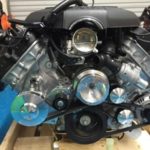 First thing’s first, you need the Coyote 5.0L engine.
First thing’s first, you need the Coyote 5.0L engine.
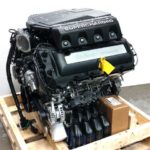 If you’re looking for a little more go-power, A Supercharged Coyote 5.0L crate engine is available. We have a master warehouse of Edelbrock. Go directly to this link for the 700 HP Coyote Street Beast
If you’re looking for a little more go-power, A Supercharged Coyote 5.0L crate engine is available. We have a master warehouse of Edelbrock. Go directly to this link for the 700 HP Coyote Street Beast
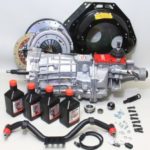 For transmission, you’ll first need to decide if you want to go manual or automatic.
The Tremec TKO-series transmission is available. These are with carbon-fiber rings to allow the higher rpm shifting which the Coyote is capable of. A low-profile top plate conversion also allows easy installation of the TKO. All this without modifying the transmission tunnel. This Coyote kit includes cross member, bell housing, clutch, fluid, fasteners, and more. More Details on the 5 Speed Kit Here Shown here is the Tremec Magnum six-speed kit. The late-model GT500 Mustang six-speed in an early Mustang means.
For transmission, you’ll first need to decide if you want to go manual or automatic.
The Tremec TKO-series transmission is available. These are with carbon-fiber rings to allow the higher rpm shifting which the Coyote is capable of. A low-profile top plate conversion also allows easy installation of the TKO. All this without modifying the transmission tunnel. This Coyote kit includes cross member, bell housing, clutch, fluid, fasteners, and more. More Details on the 5 Speed Kit Here Shown here is the Tremec Magnum six-speed kit. The late-model GT500 Mustang six-speed in an early Mustang means.
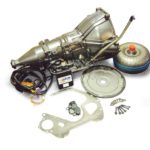 When it comes to automatic transmissions. Yes, the venerable C4 three-speed automatic will bolt up to your Coyote with bolt-on bell housing. But the 4 speed 4R70W is more ideal everything you need to get it behind your Coyote. It includes
When it comes to automatic transmissions. Yes, the venerable C4 three-speed automatic will bolt up to your Coyote with bolt-on bell housing. But the 4 speed 4R70W is more ideal everything you need to get it behind your Coyote. It includes
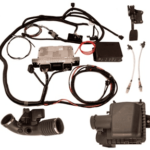 As mentioned earlier, wiring the Coyote is a breeze if you use the Control Pack kit. It includes;
As mentioned earlier, wiring the Coyote is a breeze if you use the Control Pack kit. It includes;
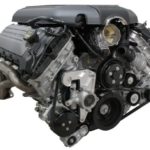 If you look back at our lead image to our story you’ll see the Ford Performance. The Coyote crate engine does not come packaged with any drive accessories. Ford offers an alternator kit with drive belt for the Coyote. Which includes the Boss 302 alternators, high-tension belt tensioner, and serpentine drive belt.
If you’re running manual steering and no A/C, the alternator kit is all you need. But if you’re looking to go all out with full accessories then you’ll need to investigate an aftermarket arrangement. One such setup is this Front Runner system. The kit uses the industry standard Sanden A/C compressor and GM Type II power steering pump. Along with custom brackets and spring-loaded belt tensioner. To offer a very compact setup on the passenger side of the engine.
If you look back at our lead image to our story you’ll see the Ford Performance. The Coyote crate engine does not come packaged with any drive accessories. Ford offers an alternator kit with drive belt for the Coyote. Which includes the Boss 302 alternators, high-tension belt tensioner, and serpentine drive belt.
If you’re running manual steering and no A/C, the alternator kit is all you need. But if you’re looking to go all out with full accessories then you’ll need to investigate an aftermarket arrangement. One such setup is this Front Runner system. The kit uses the industry standard Sanden A/C compressor and GM Type II power steering pump. Along with custom brackets and spring-loaded belt tensioner. To offer a very compact setup on the passenger side of the engine.
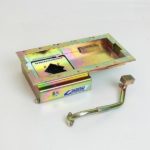 Getting the Coyote down on the mounts for many of the IFS setups. It means swapping out the production rear sump oil pan for a front sump pan. Canton Racing has the perfect answer with its new Coyote swap pans for vintage applications. Check with your suspension provider first. Though to see if they have a preferred pan that fits their suspension. Or if the stock pans will work with their cross member.
Getting the Coyote down on the mounts for many of the IFS setups. It means swapping out the production rear sump oil pan for a front sump pan. Canton Racing has the perfect answer with its new Coyote swap pans for vintage applications. Check with your suspension provider first. Though to see if they have a preferred pan that fits their suspension. Or if the stock pans will work with their cross member.
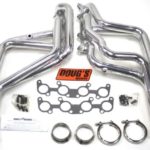 Some builders use the stock iron manifolds. This is all for the beginning of their exhaust fabrication with an engine swap. The stock manifolds on the Coyote, are a sort-of Tri-Y setup. Interfere with the chassis and steering. The best solution right now is a set of swap headers. With the Coyote swap headers for 1965-1973 Mustangs from Doug’s Headers. And you designed it to fit the TCI and Heidts Pro-G IFS systems, though they may work with other suspensions.
Some builders use the stock iron manifolds. This is all for the beginning of their exhaust fabrication with an engine swap. The stock manifolds on the Coyote, are a sort-of Tri-Y setup. Interfere with the chassis and steering. The best solution right now is a set of swap headers. With the Coyote swap headers for 1965-1973 Mustangs from Doug’s Headers. And you designed it to fit the TCI and Heidts Pro-G IFS systems, though they may work with other suspensions.
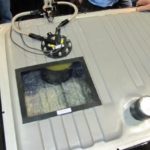 To feed that Coyote 5.0L’s EFI you’re going to need to completely revamp your vintage Mustang’s fuel system. The stock single feed line is not EFI capable. It is not to mention you’ll need a return line to the tank, a high-pressure EFI pump, and more. You have a few options here, one being the Aeromotive Phantom fuel system. In a nutshell, it is a pump, mounting bracket, and sump in one unit. Simply cut a hole in your tank and drop it in. Aeromotive offers the Phantom by itself and as a kit with EFI regulator, fittings, filter, and more. Add the length of -6 AN hose you need and an adapter fitting for the fuel rail and you’re all set.
To feed that Coyote 5.0L’s EFI you’re going to need to completely revamp your vintage Mustang’s fuel system. The stock single feed line is not EFI capable. It is not to mention you’ll need a return line to the tank, a high-pressure EFI pump, and more. You have a few options here, one being the Aeromotive Phantom fuel system. In a nutshell, it is a pump, mounting bracket, and sump in one unit. Simply cut a hole in your tank and drop it in. Aeromotive offers the Phantom by itself and as a kit with EFI regulator, fittings, filter, and more. Add the length of -6 AN hose you need and an adapter fitting for the fuel rail and you’re all set.
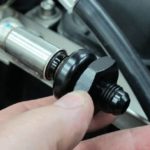 This is the Aeromotive fuel rail adapter for the modular engine like the Coyote. Slip the adapter into the open fuel rail on your crate engine until it locks in place. The opposite end is machined with a male -6 AN fitting for a standard AN hose connection. The Coyote, being returnless fuel from the factory, only has one fuel rail connection. So the fuel line routing needs to be set up. The fuel return line comes off of the fuel pressure regulator. With one pressure line connecting to the engine.
This is the Aeromotive fuel rail adapter for the modular engine like the Coyote. Slip the adapter into the open fuel rail on your crate engine until it locks in place. The opposite end is machined with a male -6 AN fitting for a standard AN hose connection. The Coyote, being returnless fuel from the factory, only has one fuel rail connection. So the fuel line routing needs to be set up. The fuel return line comes off of the fuel pressure regulator. With one pressure line connecting to the engine.
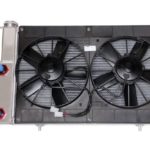 Cooling the Coyote 5.0L in your swap isn’t much difficult. You only need to understand the unique cooling hose routing of the Coyote. Ensure you either use a Degas tank or have your radiator fill point be the highest part of the cooling system. Since the Coyote, and all modular engines, the company designed to use an electric fan. That’s what you’ll have to do as well—buying a radiator and fan combo is your best bet here. C&R Racing offers a Coyote swap radiator. The C&R-based unit bolts to existing core support holes. They only need two small holes to get drilled in the bottom of the support. We’ve also used custom-built units from Flex-a-lite for modular. Coyote builds as well with great results.
Cooling the Coyote 5.0L in your swap isn’t much difficult. You only need to understand the unique cooling hose routing of the Coyote. Ensure you either use a Degas tank or have your radiator fill point be the highest part of the cooling system. Since the Coyote, and all modular engines, the company designed to use an electric fan. That’s what you’ll have to do as well—buying a radiator and fan combo is your best bet here. C&R Racing offers a Coyote swap radiator. The C&R-based unit bolts to existing core support holes. They only need two small holes to get drilled in the bottom of the support. We’ve also used custom-built units from Flex-a-lite for modular. Coyote builds as well with great results.
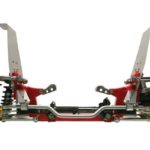 So you’ve figured out your engine and transmission choices and now you’re ready to go, tools in hand. If you haven’t noticed actual fitting the Coyote into your Mustang. Then that is going to need some reconfiguring of the engine bay. A popular route is a new independent front suspension (IFS). It relocates the spring to the lower arm and eliminates the shock/spring towers. There are a number of companies that offer solutions. Total Cost Involved (TCI) Engineering. The TCI Engineering system welds into the front frame rails. Then the suspension pieces bolt to the new subframe, providing ample clearance. The Roadster Shop offers its own IFS that utilizes modern Corvette spindles. A splined antisway bar, and other high-end goodies for a suspension. That not only allows Coyote fitment but can easily tackle the road course as well.
So you’ve figured out your engine and transmission choices and now you’re ready to go, tools in hand. If you haven’t noticed actual fitting the Coyote into your Mustang. Then that is going to need some reconfiguring of the engine bay. A popular route is a new independent front suspension (IFS). It relocates the spring to the lower arm and eliminates the shock/spring towers. There are a number of companies that offer solutions. Total Cost Involved (TCI) Engineering. The TCI Engineering system welds into the front frame rails. Then the suspension pieces bolt to the new subframe, providing ample clearance. The Roadster Shop offers its own IFS that utilizes modern Corvette spindles. A splined antisway bar, and other high-end goodies for a suspension. That not only allows Coyote fitment but can easily tackle the road course as well.
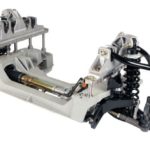 Detroit Speed’s Aluma-Frame IFS is another, very capable IFS. That person can consider as well and comes ready to fit the Coyote engine. The aluminum subframe structure bolts to the stock frame rails. Then sandwiches it after welding on the mounting plates. Detroit Speed’s instructions offer several part numbers for Coyote fitment, including,
Detroit Speed’s Aluma-Frame IFS is another, very capable IFS. That person can consider as well and comes ready to fit the Coyote engine. The aluminum subframe structure bolts to the stock frame rails. Then sandwiches it after welding on the mounting plates. Detroit Speed’s instructions offer several part numbers for Coyote fitment, including,
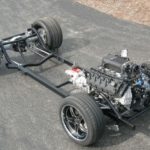 You are thinking all-new suspension front and rear for your Coyote build. You might want to forego the typical suspension kits. You need to upgrade a full perimeter frame. Offering like those from the Roadster Shop and Schwartz Performance. Simply trim away your stock front shock towers and frame rails. Weld a few mounting tabs to your Mustang’s unibody, and bolt it down on this performance frame package.
You are thinking all-new suspension front and rear for your Coyote build. You might want to forego the typical suspension kits. You need to upgrade a full perimeter frame. Offering like those from the Roadster Shop and Schwartz Performance. Simply trim away your stock front shock towers and frame rails. Weld a few mounting tabs to your Mustang’s unibody, and bolt it down on this performance frame package.
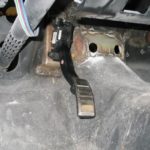 The Control Pack needs a drive-by-wire pedal. It will need you to mount thorough a custom-fabricated mount. This is an earlier pedal shown installed here, but it gives you an idea of what needs to complete. This fabbed bracket from steel sheet and bolts welded to it as mounting studs at the top and a nut for a bolt at the bottom.
The Control Pack needs a drive-by-wire pedal. It will need you to mount thorough a custom-fabricated mount. This is an earlier pedal shown installed here, but it gives you an idea of what needs to complete. This fabbed bracket from steel sheet and bolts welded to it as mounting studs at the top and a nut for a bolt at the bottom.
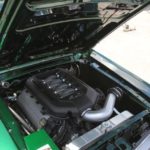 One part of the Control Pack will be the airbox and possibly the inlet ducting. Depending upon accessory mounting an engine bay you might be able to get an aftermarket cold air kit to work. Like this JLT (www.jlttruecoldair.com) system shown here on a 2013 Coyote Mustang GT with a little fuss. Alternatively, you can fab your own inlet tubing and add a mass air sensor mount and a filter to the end, as in the case of this Coyote install in a 1967 fastback. Several companies offer universal tubing, mass air sensor mounts, and filters. Gateway Classic Mustang offers a Coyote in a vintage Mustang cold air kit too, ready to go.
One part of the Control Pack will be the airbox and possibly the inlet ducting. Depending upon accessory mounting an engine bay you might be able to get an aftermarket cold air kit to work. Like this JLT (www.jlttruecoldair.com) system shown here on a 2013 Coyote Mustang GT with a little fuss. Alternatively, you can fab your own inlet tubing and add a mass air sensor mount and a filter to the end, as in the case of this Coyote install in a 1967 fastback. Several companies offer universal tubing, mass air sensor mounts, and filters. Gateway Classic Mustang offers a Coyote in a vintage Mustang cold air kit too, ready to go.
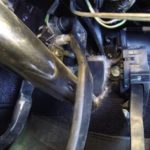 One area that can be a bit of an issue is the brake master cylinder. Due to the massive width of the Coyote 5.0L even using a manual brake master cylinder. It’s mounted to the firewall can be an issue, especially in 1965-1966 applications. This is due to the near flat mounting surface of the 1965-1966 firewall versus the recessed mounting area found on the 1967-1970 firewall. The answer is to move the master cylinder over roughly 1 3/4 inches.
This will need widening the pedal support, adding length to the brake pedal arm pin, and moving the clutch pedal over as well. If it’s a manual trans car. You can see in these photos, how they moved the master cylinder over and modified the brake pedal and support accordingly. For the 1967-1970 firewall, the master cylinder will bolt directly to the OE holes and should clear the cam cover. Ensure you use a master cylinder with outlets facing the inner fender and not toward the engine. Stang-Aholics uses this dual reservoir unit from ABS Power Brake in their swaps.
One area that can be a bit of an issue is the brake master cylinder. Due to the massive width of the Coyote 5.0L even using a manual brake master cylinder. It’s mounted to the firewall can be an issue, especially in 1965-1966 applications. This is due to the near flat mounting surface of the 1965-1966 firewall versus the recessed mounting area found on the 1967-1970 firewall. The answer is to move the master cylinder over roughly 1 3/4 inches.
This will need widening the pedal support, adding length to the brake pedal arm pin, and moving the clutch pedal over as well. If it’s a manual trans car. You can see in these photos, how they moved the master cylinder over and modified the brake pedal and support accordingly. For the 1967-1970 firewall, the master cylinder will bolt directly to the OE holes and should clear the cam cover. Ensure you use a master cylinder with outlets facing the inner fender and not toward the engine. Stang-Aholics uses this dual reservoir unit from ABS Power Brake in their swaps.
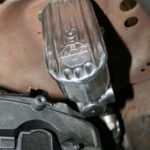 Speaking of power brakes, as you can imagine, there is no way you’re getting a traditional vacuum diaphragm booster in such a tight spot. We’ve used hydraulic assist units in previous builds, aka hydroboost. But they need power steering and some additional line plumbing. Though they work great. A new, more compact option is a remote hydro-electric setup. Stang-Aholics uses this setup from ABS Power Brake that utilizes a small reservoir,
Speaking of power brakes, as you can imagine, there is no way you’re getting a traditional vacuum diaphragm booster in such a tight spot. We’ve used hydraulic assist units in previous builds, aka hydroboost. But they need power steering and some additional line plumbing. Though they work great. A new, more compact option is a remote hydro-electric setup. Stang-Aholics uses this setup from ABS Power Brake that utilizes a small reservoir,
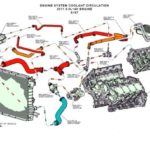 Most of the coolant hoses come with the harness kit.
Most of the coolant hoses come with the harness kit.
- vintage Mustang
- Fox body Mustang
- Restomod project.
- The Coyote’s cylinder head design,
- camshafts,
- and trick electronic valve timing control
- each cam controlled with independence
 First thing’s first, you need the Coyote 5.0L engine.
First thing’s first, you need the Coyote 5.0L engine.
 If you’re looking for a little more go-power, A Supercharged Coyote 5.0L crate engine is available. We have a master warehouse of Edelbrock. Go directly to this link for the 700 HP Coyote Street Beast
If you’re looking for a little more go-power, A Supercharged Coyote 5.0L crate engine is available. We have a master warehouse of Edelbrock. Go directly to this link for the 700 HP Coyote Street Beast
 For transmission, you’ll first need to decide if you want to go manual or automatic.
The Tremec TKO-series transmission is available. These are with carbon-fiber rings to allow the higher rpm shifting which the Coyote is capable of. A low-profile top plate conversion also allows easy installation of the TKO. All this without modifying the transmission tunnel. This Coyote kit includes cross member, bell housing, clutch, fluid, fasteners, and more. More Details on the 5 Speed Kit Here Shown here is the Tremec Magnum six-speed kit. The late-model GT500 Mustang six-speed in an early Mustang means.
For transmission, you’ll first need to decide if you want to go manual or automatic.
The Tremec TKO-series transmission is available. These are with carbon-fiber rings to allow the higher rpm shifting which the Coyote is capable of. A low-profile top plate conversion also allows easy installation of the TKO. All this without modifying the transmission tunnel. This Coyote kit includes cross member, bell housing, clutch, fluid, fasteners, and more. More Details on the 5 Speed Kit Here Shown here is the Tremec Magnum six-speed kit. The late-model GT500 Mustang six-speed in an early Mustang means.
- having to cut the top of the transmission tunnel,
- change out or remove the floor support,
- and more to get the correct driveline angle.
 When it comes to automatic transmissions. Yes, the venerable C4 three-speed automatic will bolt up to your Coyote with bolt-on bell housing. But the 4 speed 4R70W is more ideal everything you need to get it behind your Coyote. It includes
When it comes to automatic transmissions. Yes, the venerable C4 three-speed automatic will bolt up to your Coyote with bolt-on bell housing. But the 4 speed 4R70W is more ideal everything you need to get it behind your Coyote. It includes
- Smart Shift electronics,
- manual lever sensor,
- block plate, flexplate,
- converter,
- and attaching bolts.
- With the 4R70W, Ford builds one tough overdrive automatic. Learning from the AOD’s weaknesses and improving on its strengths. The 4R70W handles 700 lb-ft of torque in stock build. Configuration and features a wide-ratio gear set (the 70 and W in the name in accordance. Add an aftermarket controller, you can adjust shift points,
- shift feel,
- converter lockup,
- and more by turning a knob.
 As mentioned earlier, wiring the Coyote is a breeze if you use the Control Pack kit. It includes;
As mentioned earlier, wiring the Coyote is a breeze if you use the Control Pack kit. It includes;
- The body harness,
- Inlet ducting
- And air box,
- Drive-by-wire throttle pedal,
- Oxygen sensors,
- And fuse box.
 If you look back at our lead image to our story you’ll see the Ford Performance. The Coyote crate engine does not come packaged with any drive accessories. Ford offers an alternator kit with drive belt for the Coyote. Which includes the Boss 302 alternators, high-tension belt tensioner, and serpentine drive belt.
If you’re running manual steering and no A/C, the alternator kit is all you need. But if you’re looking to go all out with full accessories then you’ll need to investigate an aftermarket arrangement. One such setup is this Front Runner system. The kit uses the industry standard Sanden A/C compressor and GM Type II power steering pump. Along with custom brackets and spring-loaded belt tensioner. To offer a very compact setup on the passenger side of the engine.
If you look back at our lead image to our story you’ll see the Ford Performance. The Coyote crate engine does not come packaged with any drive accessories. Ford offers an alternator kit with drive belt for the Coyote. Which includes the Boss 302 alternators, high-tension belt tensioner, and serpentine drive belt.
If you’re running manual steering and no A/C, the alternator kit is all you need. But if you’re looking to go all out with full accessories then you’ll need to investigate an aftermarket arrangement. One such setup is this Front Runner system. The kit uses the industry standard Sanden A/C compressor and GM Type II power steering pump. Along with custom brackets and spring-loaded belt tensioner. To offer a very compact setup on the passenger side of the engine.
5.0 Coyote Engine Swap Kit
 Getting the Coyote down on the mounts for many of the IFS setups. It means swapping out the production rear sump oil pan for a front sump pan. Canton Racing has the perfect answer with its new Coyote swap pans for vintage applications. Check with your suspension provider first. Though to see if they have a preferred pan that fits their suspension. Or if the stock pans will work with their cross member.
Getting the Coyote down on the mounts for many of the IFS setups. It means swapping out the production rear sump oil pan for a front sump pan. Canton Racing has the perfect answer with its new Coyote swap pans for vintage applications. Check with your suspension provider first. Though to see if they have a preferred pan that fits their suspension. Or if the stock pans will work with their cross member.
 Some builders use the stock iron manifolds. This is all for the beginning of their exhaust fabrication with an engine swap. The stock manifolds on the Coyote, are a sort-of Tri-Y setup. Interfere with the chassis and steering. The best solution right now is a set of swap headers. With the Coyote swap headers for 1965-1973 Mustangs from Doug’s Headers. And you designed it to fit the TCI and Heidts Pro-G IFS systems, though they may work with other suspensions.
Some builders use the stock iron manifolds. This is all for the beginning of their exhaust fabrication with an engine swap. The stock manifolds on the Coyote, are a sort-of Tri-Y setup. Interfere with the chassis and steering. The best solution right now is a set of swap headers. With the Coyote swap headers for 1965-1973 Mustangs from Doug’s Headers. And you designed it to fit the TCI and Heidts Pro-G IFS systems, though they may work with other suspensions.
 To feed that Coyote 5.0L’s EFI you’re going to need to completely revamp your vintage Mustang’s fuel system. The stock single feed line is not EFI capable. It is not to mention you’ll need a return line to the tank, a high-pressure EFI pump, and more. You have a few options here, one being the Aeromotive Phantom fuel system. In a nutshell, it is a pump, mounting bracket, and sump in one unit. Simply cut a hole in your tank and drop it in. Aeromotive offers the Phantom by itself and as a kit with EFI regulator, fittings, filter, and more. Add the length of -6 AN hose you need and an adapter fitting for the fuel rail and you’re all set.
To feed that Coyote 5.0L’s EFI you’re going to need to completely revamp your vintage Mustang’s fuel system. The stock single feed line is not EFI capable. It is not to mention you’ll need a return line to the tank, a high-pressure EFI pump, and more. You have a few options here, one being the Aeromotive Phantom fuel system. In a nutshell, it is a pump, mounting bracket, and sump in one unit. Simply cut a hole in your tank and drop it in. Aeromotive offers the Phantom by itself and as a kit with EFI regulator, fittings, filter, and more. Add the length of -6 AN hose you need and an adapter fitting for the fuel rail and you’re all set.
 This is the Aeromotive fuel rail adapter for the modular engine like the Coyote. Slip the adapter into the open fuel rail on your crate engine until it locks in place. The opposite end is machined with a male -6 AN fitting for a standard AN hose connection. The Coyote, being returnless fuel from the factory, only has one fuel rail connection. So the fuel line routing needs to be set up. The fuel return line comes off of the fuel pressure regulator. With one pressure line connecting to the engine.
This is the Aeromotive fuel rail adapter for the modular engine like the Coyote. Slip the adapter into the open fuel rail on your crate engine until it locks in place. The opposite end is machined with a male -6 AN fitting for a standard AN hose connection. The Coyote, being returnless fuel from the factory, only has one fuel rail connection. So the fuel line routing needs to be set up. The fuel return line comes off of the fuel pressure regulator. With one pressure line connecting to the engine.
Mustang Coyote Motor Spec
 Cooling the Coyote 5.0L in your swap isn’t much difficult. You only need to understand the unique cooling hose routing of the Coyote. Ensure you either use a Degas tank or have your radiator fill point be the highest part of the cooling system. Since the Coyote, and all modular engines, the company designed to use an electric fan. That’s what you’ll have to do as well—buying a radiator and fan combo is your best bet here. C&R Racing offers a Coyote swap radiator. The C&R-based unit bolts to existing core support holes. They only need two small holes to get drilled in the bottom of the support. We’ve also used custom-built units from Flex-a-lite for modular. Coyote builds as well with great results.
Cooling the Coyote 5.0L in your swap isn’t much difficult. You only need to understand the unique cooling hose routing of the Coyote. Ensure you either use a Degas tank or have your radiator fill point be the highest part of the cooling system. Since the Coyote, and all modular engines, the company designed to use an electric fan. That’s what you’ll have to do as well—buying a radiator and fan combo is your best bet here. C&R Racing offers a Coyote swap radiator. The C&R-based unit bolts to existing core support holes. They only need two small holes to get drilled in the bottom of the support. We’ve also used custom-built units from Flex-a-lite for modular. Coyote builds as well with great results.
 So you’ve figured out your engine and transmission choices and now you’re ready to go, tools in hand. If you haven’t noticed actual fitting the Coyote into your Mustang. Then that is going to need some reconfiguring of the engine bay. A popular route is a new independent front suspension (IFS). It relocates the spring to the lower arm and eliminates the shock/spring towers. There are a number of companies that offer solutions. Total Cost Involved (TCI) Engineering. The TCI Engineering system welds into the front frame rails. Then the suspension pieces bolt to the new subframe, providing ample clearance. The Roadster Shop offers its own IFS that utilizes modern Corvette spindles. A splined antisway bar, and other high-end goodies for a suspension. That not only allows Coyote fitment but can easily tackle the road course as well.
So you’ve figured out your engine and transmission choices and now you’re ready to go, tools in hand. If you haven’t noticed actual fitting the Coyote into your Mustang. Then that is going to need some reconfiguring of the engine bay. A popular route is a new independent front suspension (IFS). It relocates the spring to the lower arm and eliminates the shock/spring towers. There are a number of companies that offer solutions. Total Cost Involved (TCI) Engineering. The TCI Engineering system welds into the front frame rails. Then the suspension pieces bolt to the new subframe, providing ample clearance. The Roadster Shop offers its own IFS that utilizes modern Corvette spindles. A splined antisway bar, and other high-end goodies for a suspension. That not only allows Coyote fitment but can easily tackle the road course as well.
Ford 5.0 Mustang Coyote Engine
 Detroit Speed’s Aluma-Frame IFS is another, very capable IFS. That person can consider as well and comes ready to fit the Coyote engine. The aluminum subframe structure bolts to the stock frame rails. Then sandwiches it after welding on the mounting plates. Detroit Speed’s instructions offer several part numbers for Coyote fitment, including,
Detroit Speed’s Aluma-Frame IFS is another, very capable IFS. That person can consider as well and comes ready to fit the Coyote engine. The aluminum subframe structure bolts to the stock frame rails. Then sandwiches it after welding on the mounting plates. Detroit Speed’s instructions offer several part numbers for Coyote fitment, including,
- Headers,
- Oil pan, and more.
Coyote Motor Swap
Fatman Fabrications has an interesting offering for strut IFS builds. Its modular system uses a series of bolt on tubular supports. And stamped metal panels to completely reform the engine bay. It offers the most clearance for the wide Coyote. Bolt on engine mount adapters and firewall/core support bracing includes in it. You are thinking all-new suspension front and rear for your Coyote build. You might want to forego the typical suspension kits. You need to upgrade a full perimeter frame. Offering like those from the Roadster Shop and Schwartz Performance. Simply trim away your stock front shock towers and frame rails. Weld a few mounting tabs to your Mustang’s unibody, and bolt it down on this performance frame package.
You are thinking all-new suspension front and rear for your Coyote build. You might want to forego the typical suspension kits. You need to upgrade a full perimeter frame. Offering like those from the Roadster Shop and Schwartz Performance. Simply trim away your stock front shock towers and frame rails. Weld a few mounting tabs to your Mustang’s unibody, and bolt it down on this performance frame package.
 The Control Pack needs a drive-by-wire pedal. It will need you to mount thorough a custom-fabricated mount. This is an earlier pedal shown installed here, but it gives you an idea of what needs to complete. This fabbed bracket from steel sheet and bolts welded to it as mounting studs at the top and a nut for a bolt at the bottom.
The Control Pack needs a drive-by-wire pedal. It will need you to mount thorough a custom-fabricated mount. This is an earlier pedal shown installed here, but it gives you an idea of what needs to complete. This fabbed bracket from steel sheet and bolts welded to it as mounting studs at the top and a nut for a bolt at the bottom.
 One part of the Control Pack will be the airbox and possibly the inlet ducting. Depending upon accessory mounting an engine bay you might be able to get an aftermarket cold air kit to work. Like this JLT (www.jlttruecoldair.com) system shown here on a 2013 Coyote Mustang GT with a little fuss. Alternatively, you can fab your own inlet tubing and add a mass air sensor mount and a filter to the end, as in the case of this Coyote install in a 1967 fastback. Several companies offer universal tubing, mass air sensor mounts, and filters. Gateway Classic Mustang offers a Coyote in a vintage Mustang cold air kit too, ready to go.
One part of the Control Pack will be the airbox and possibly the inlet ducting. Depending upon accessory mounting an engine bay you might be able to get an aftermarket cold air kit to work. Like this JLT (www.jlttruecoldair.com) system shown here on a 2013 Coyote Mustang GT with a little fuss. Alternatively, you can fab your own inlet tubing and add a mass air sensor mount and a filter to the end, as in the case of this Coyote install in a 1967 fastback. Several companies offer universal tubing, mass air sensor mounts, and filters. Gateway Classic Mustang offers a Coyote in a vintage Mustang cold air kit too, ready to go.
 One area that can be a bit of an issue is the brake master cylinder. Due to the massive width of the Coyote 5.0L even using a manual brake master cylinder. It’s mounted to the firewall can be an issue, especially in 1965-1966 applications. This is due to the near flat mounting surface of the 1965-1966 firewall versus the recessed mounting area found on the 1967-1970 firewall. The answer is to move the master cylinder over roughly 1 3/4 inches.
This will need widening the pedal support, adding length to the brake pedal arm pin, and moving the clutch pedal over as well. If it’s a manual trans car. You can see in these photos, how they moved the master cylinder over and modified the brake pedal and support accordingly. For the 1967-1970 firewall, the master cylinder will bolt directly to the OE holes and should clear the cam cover. Ensure you use a master cylinder with outlets facing the inner fender and not toward the engine. Stang-Aholics uses this dual reservoir unit from ABS Power Brake in their swaps.
One area that can be a bit of an issue is the brake master cylinder. Due to the massive width of the Coyote 5.0L even using a manual brake master cylinder. It’s mounted to the firewall can be an issue, especially in 1965-1966 applications. This is due to the near flat mounting surface of the 1965-1966 firewall versus the recessed mounting area found on the 1967-1970 firewall. The answer is to move the master cylinder over roughly 1 3/4 inches.
This will need widening the pedal support, adding length to the brake pedal arm pin, and moving the clutch pedal over as well. If it’s a manual trans car. You can see in these photos, how they moved the master cylinder over and modified the brake pedal and support accordingly. For the 1967-1970 firewall, the master cylinder will bolt directly to the OE holes and should clear the cam cover. Ensure you use a master cylinder with outlets facing the inner fender and not toward the engine. Stang-Aholics uses this dual reservoir unit from ABS Power Brake in their swaps.
Fox Body Coyote Swap
 Speaking of power brakes, as you can imagine, there is no way you’re getting a traditional vacuum diaphragm booster in such a tight spot. We’ve used hydraulic assist units in previous builds, aka hydroboost. But they need power steering and some additional line plumbing. Though they work great. A new, more compact option is a remote hydro-electric setup. Stang-Aholics uses this setup from ABS Power Brake that utilizes a small reservoir,
Speaking of power brakes, as you can imagine, there is no way you’re getting a traditional vacuum diaphragm booster in such a tight spot. We’ve used hydraulic assist units in previous builds, aka hydroboost. But they need power steering and some additional line plumbing. Though they work great. A new, more compact option is a remote hydro-electric setup. Stang-Aholics uses this setup from ABS Power Brake that utilizes a small reservoir,
- an electric pump,
- and a high-pressure accumulator
 Most of the coolant hoses come with the harness kit.
Most of the coolant hoses come with the harness kit. 